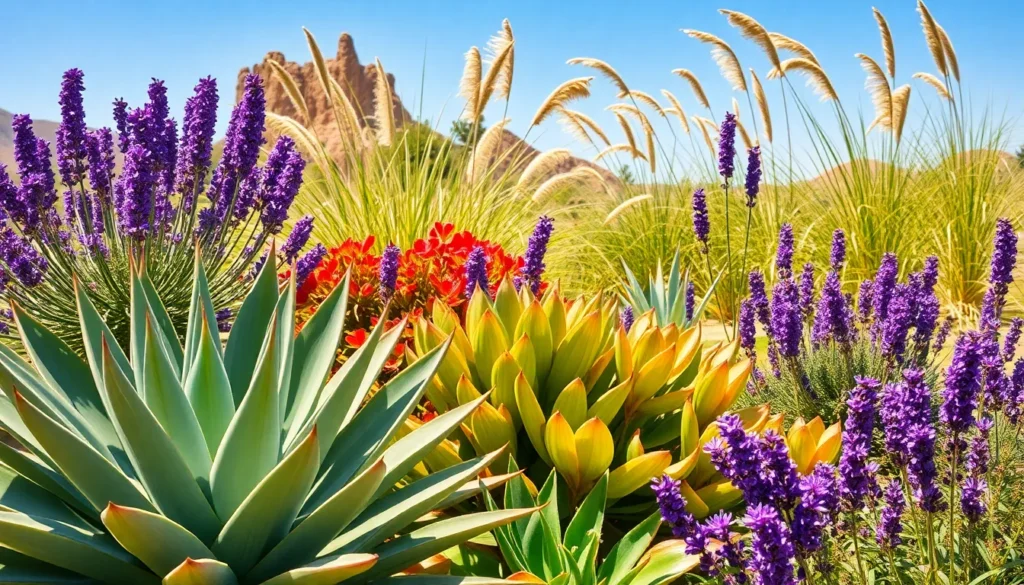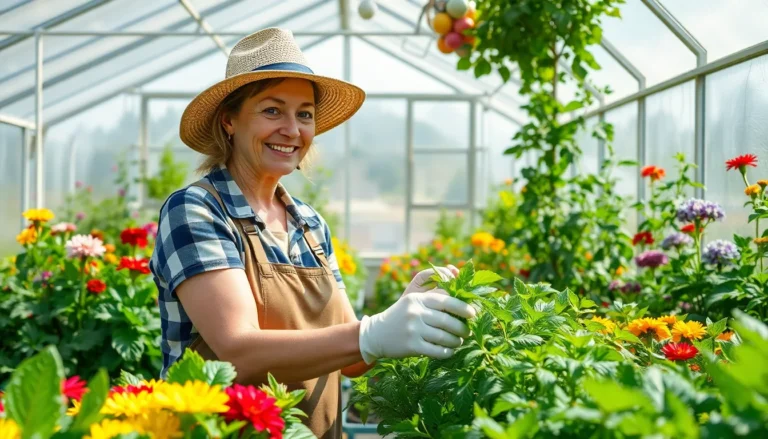Table of Contents
ToggleIn a world where water bills can rival a small country’s GDP, drought-tolerant plants are the unsung heroes of the garden. These resilient green warriors thrive where others wither, proving that you don’t need to be a water hog to have a lush landscape. Imagine a garden that not only survives but thrives on minimal moisture, turning heads and saving dollars.
What Are Drought-Tolerant Plants?
Drought-tolerant plants are species that adapt well to dry conditions, thriving on minimal water. These plants possess specific characteristics enabling them to survive prolonged periods without rainfall. Examples of these traits include deep root systems, thick leaves, and waxy surface coatings that reduce water loss.
Many popular options fall into the category of drought-tolerant plants. Succulents, such as agave and aloe vera, store water in their tissues, making them ideal for arid environments. Native grasses and certain perennials, like lavender and sedum, require less water once established.
These plants play a significant role in sustainable landscaping. Gardeners benefit from their low-maintenance needs, reducing the time spent on watering and upkeep. Additionally, drought-tolerant plants contribute to conserving water resources, ensuring healthier ecosystems.
Landscapes featuring drought-tolerant plants often remain vibrant and colorful, even in dry spells. Many varieties bloom throughout the growing season, providing beauty while supporting local wildlife. Pollinators, such as bees and butterflies, are particularly attracted to these plants, fostering biodiversity.
In terms of climate adaptability, drought-tolerant plants excel. They suit various regions, from deserts to temperate zones, allowing flexibility in design choices. Gardeners can achieve stunning designs while meeting environmental needs and preferences.
Benefits of Drought-Tolerant Plants

Drought-tolerant plants offer numerous advantages for gardeners and the environment. These benefits range from ecological improvements to cost savings on water usage.
Environmental Advantages
Drought-tolerant plants contribute to ecosystem health by requiring less water, which conserves precious resources. They adapt well to local climates, reducing the need for irrigation systems. Pollinators such as bees and butterflies thrive in landscapes filled with these plants, which support biodiversity. Many drought-tolerant species, like native grasses and perennials, enhance soil quality through their expansive root systems. Such plants help to reduce soil erosion as well, maintaining landscape integrity in times of dry weather.
Economic Considerations
Investing in drought-tolerant plants lowers water bills significantly. Gardeners spend less on irrigation supplies and upkeep, allowing funds to allocate elsewhere. These plants often require minimal maintenance, leading to reduced costs over time. Initial plant purchase prices can be offset by long-term water savings, making them economically sensible. Additionally, many areas offer incentives for using drought-resistant landscaping, providing potential rebates for environmentally conscious choices.
Popular Drought-Tolerant Plants
Drought-tolerant plants come in various types, each offering unique benefits to gardeners. These options include native species and ornamental plants.
Native Species
Native plants excel in drought conditions due to their natural adaptation to local climates. Varieties such as California poppy provide vibrant color while requiring minimal water. Coneflower attracts pollinators, thriving in dry soil conditions. Another beneficial option, purple aster, supports local ecosystems by serving as a pollen source. Each of these species contributes to a sustainable landscape while promoting biodiversity. Choosing native varieties ensures gardeners create habitats for butterflies and bees.
Ornamental Options
Ornamental drought-tolerant plants enhance aesthetics in landscapes. Succulents like agave and aloe vera not only conserve water but also add texture and interest. Lavenders emit delightful fragrances and resist drought, making them ideal for gardens. Another great choice, sedum, offers vibrant hues and remains resilient under dry conditions. Colorful succulents, such as echeveria, make striking focal points. Each ornamental option brings beauty and practicality, supporting efforts toward sustainable gardening.
Tips for Caring for Drought-Tolerant Plants
Caring for drought-tolerant plants involves thoughtful approaches to soil and watering. These techniques ensure optimal growth and resilience under dry conditions.
Soil Preparation
Successful growth of drought-tolerant plants relies on well-draining soil. Incorporating organic matter like compost enhances soil aeration and water retention, even in arid conditions. Testing soil for pH and nutrient levels helps identify necessary amendments. Selecting native soil mixes when possible supports local plant adaptations. Mulching around plants reduces evaporation and prevents weed growth. Regularly checking soil moisture levels provides insights into water needs without over-saturating roots.
Watering Techniques
Implementing efficient watering strategies is crucial for establishing drought-tolerant plants. Initially, deep watering encourages roots to grow deep into the soil. A drip irrigation system minimizes water loss and directs moisture directly to roots. Watering in early mornings or late evenings reduces evaporation rates. Gradually adjusting watering frequency promotes drought resilience over time. Observing the plants for signs of stress ensures they receive adequate care tailored to their needs.
Embracing drought-tolerant plants is a smart choice for any gardener looking to create a sustainable and vibrant landscape. These resilient species not only conserve water but also enhance the beauty of outdoor spaces. By selecting plants that thrive in local climates, gardeners can support biodiversity and attract essential pollinators.
With proper care and thoughtful planning, drought-tolerant gardens can flourish while minimizing environmental impact. The combination of aesthetic appeal and practicality makes these plants an ideal solution for modern landscaping challenges. As water conservation becomes increasingly important, choosing drought-tolerant options will contribute to a greener future.







